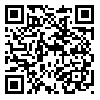BibTeX | RIS | EndNote | Medlars | ProCite | Reference Manager | RefWorks
Send citation to:
URL: http://ioh.iums.ac.ir/article-1-753-en.html
Background and aims : Developing intelligent systems to prevent car accidents can be very effective in minimizing accident death toll. One of the factors which play an important role in accidents is the human errors. Fatigue driving is one of the cases that can cause errors and reduce accuracy in contorlling the vehicle.
Methods : The signs of fatigue and sleepiness while driving is revealed based on video processing techniques. In this model, the person’s face is filmed by a camera in the first step by receiving 15fps video sequence. Then, the images are transformed from RGB space into YCbCr and HSV spaces. The face area is separated from other parts. That the eyes are open or closed in a specific time interval is determined by focusing on thresholding and equations concerning the symmetry of human faces a finally using K-means Clustering, the frequency of yawning is identified. In the evaluation phase, the implementation of the algorithm on video sequences recorded under real conditions in urban and suburban areas and compared with methods such as Visual Information and Monitoring Driver Vigilance , better performance was achieved.
Results : The proposed system has been implemented on different video sequences with average accuracy of 93.18% and detection rate (DR) of 92.71% out of total 5900 image frames.
Conclusion : High accuracy in segmentation, low error rate and quick processing of input data distinguishes this system from similar ones. This system can minimize the number of accidents caused by drivers’ fatigue
Received: 2012/07/3 | Accepted: 2013/09/29 | Published: 2013/09/29
| Rights and permissions | |
 |
This work is licensed under a Creative Commons Attribution-NonCommercial 4.0 International License. |



